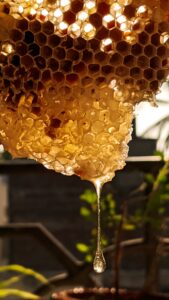 Honey is a sweet and expensive liquid that is produced by bees. Bees process honey from the sugar secretion of plants and flowers with enzymatic activity and water vapor. Bees store honey in waxy structures called hives. Honey processed by bees is best known for its global processing and commercialization.
Honey is a sweet and expensive liquid that is produced by bees. Bees process honey from the sugar secretion of plants and flowers with enzymatic activity and water vapor. Bees store honey in waxy structures called hives. Honey processed by bees is best known for its global processing and commercialization.
Honey is collected from wild bee colonies or from native beehives, which is called beekeeping.
 Honey derives its sweetness from monosaccharides, fructose and glucose, and its relative sweetness is as much as sucrose. The caloric content of honey is about 325 kcal of energy per 100 grams. Honey has the highest rank among foods in terms of having some fermented substances in food exchanges and helping digestion.
Honey derives its sweetness from monosaccharides, fructose and glucose, and its relative sweetness is as much as sucrose. The caloric content of honey is about 325 kcal of energy per 100 grams. Honey has the highest rank among foods in terms of having some fermented substances in food exchanges and helping digestion.
Most germs do not grow in honey, so sealed honey does not decompose for thousands of years. Honey is also difficult to decompose due to its special acidity, very small amount of water and the presence of hydrogen peroxide, making it easy to store, transport and trade. Before sugarcane syrup was crystallized and sugar was prepared, honey was the only food used by humans for sweetening. Honey is dangerous for children under the age of two due to the production of botulinum toxin.
Honey sugares spontaneously over time, and this is a natural process that has no effect on its chemical properties or quality. Hot water can be used to melt this sugar, but it should be noted that if honey is heated to a temperature of more than 40 degrees Celsius, its biologically active ingredients will be lost.
Due to the high importance of bees in pollination and increasing the fertility of agricultural products and fruits, the World Food and Agriculture Organization (FAO) has designated May 20 each year as “World Bee Day”.
Attributes
An important feature of honey is that it does not spoil in the long run. [Citation needed] It is also used to keep some ingredients away from spoilage. It will take its place, and in this way the lust will not rot for a year. Another is that this substance loses its nutritional value only if it is exposed to temperatures above 60 degrees.
Honey is the only natural food that does not spoil.
The specific gravity of honey at 20 ° C is about 1.4-1.42 and its average pH is about 3.9, but it can vary in the range of 3.4 to 6.1; Therefore, although honey is an acidic substance, but due to its special sweetness, its acidic state is not noticeable.
How to detect natural honey
 There is a misconception that if honey binds clay or corrects sugar, it is counterfeit, while the reason for sugaring honey is due to the presence of glucose (one of the sugars in honey); Because honey, whether natural, nutritional, or counterfeit, contains this sugar in its structure, sugaring can occur for any honey, and therefore sugaring can not be a good measure of whether honey is natural or counterfeit.
There is a misconception that if honey binds clay or corrects sugar, it is counterfeit, while the reason for sugaring honey is due to the presence of glucose (one of the sugars in honey); Because honey, whether natural, nutritional, or counterfeit, contains this sugar in its structure, sugaring can occur for any honey, and therefore sugaring can not be a good measure of whether honey is natural or counterfeit.
Some people also think that it is possible to distinguish the type of honey from the color, concentration or flavor of honey, while these are not good criteria for identifying good honey. Even natural honeys may have different concentrations, flavors, and colors, depending on where they are produced or what flowers and plants the bee has fed to produce them.
Therefore, honey can not be properly evaluated from the usual methods. The best way, and in fact the only way to distinguish natural honey from counterfeit, is to test honey in the laboratory. In the honey test, factors such as sucrose, proline, diastase and HMF of honey are examined. By examining these factors and comparing them with standard amounts of natural honey, one can determine whether honey is good or bad.






